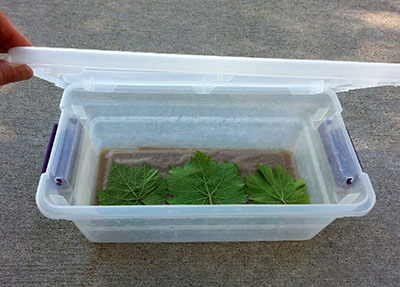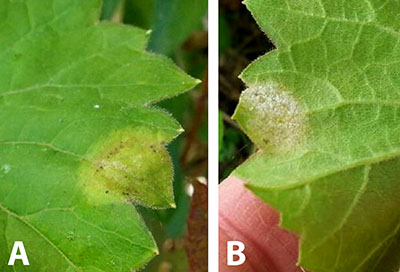Mysterious yellow spots on grape leaves are not downy mildew
Yellow spots recently noticed on grape leaves are not downy mildew, but continued scouting is advised as downy mildew could occur in the near future.

In late May, small, yellow spots on grape leaves were noticed by growers and vineyard scouts in multiple vineyards in southwest Michigan. Usually a single spot per leaf was seen on a range of grape cultivars. The spots were small with a diffuse margin (Photo 1). No sporulation was visible on the lower leaf surface. Similar spotting on grape leaves has occurred around this time of the season in previous years. However, there is no cause for alarm since the spots are not downy mildew. The cause of the yellow spotting is unclear, but it may be related to drift of certain herbicides such as paraquat. Very small droplets may cause yellow spots on leaves whereas larger droplets may cause necrotic spotting. There is also a possibility that the spots are weather-related, such as freezing temperatures during early leaf development.
Just to be sure, the leaves were incubated on wet paper towels in a plastic box for several days. No white sporulation was observed on the underside of the lesions (Photo 2). This is a simple test growers can also use with fresh leaves – it will not work on wilted or dry leaves as the downy mildew pathogen dies when the leaf dies. The leaves, with the lower surface facing up, are incubated overnight in the dark. If the spot is caused by downy mildew, white spores will become visible the next day. Downy mildew spores are easier to observe on non-hairy grape leaves, but even on hairy leaves there should be a distinct raised patch of white fluffy spores.

Photo 2. To determine if yellow spots are caused by downy mildew, place leaves with the lower side up on a moist paper towel in a plastic container. Close and place in the dark overnight. In 24-28 hours, white, fluffy sporulation should become visible if downy mildew is present.
When you compare the appearance of the yellow spots with young downy mildew lesions (Photo 3), downy mildew lesions tend to be larger and have more distinct margins; they are also called “oil spots” due to their somewhat greasy appearance. There usually is white sporulation on the lower leaf surface, but the fungus does need high relative humidity and moderate temperatures to sporulate. Thus, cold or dry weather may slow down sporulation.
Also, certain fungicides may halt or reduce spore production. That said, we have started seeing the first downy mildew “oils spots” on leaves of wild grapes (riverbank grape or Vitis riparia) this week. Often, downy mildew is first seen in wild grapes because they tend to grow low to the ground amidst higher humidity and close proximity to overwintering oospores. I use the first detection in wild grapes as a warning system for downy mildew activity in cultivated grapes. So keep calm and keep scouting!

Photo 3. For comparison, a young downy mildew lesion or “oil spot” on wild grape upper (A) and lower (B) leaf surface.
Dr. Schilder’s work is funded in part by MSU’s AgBioResearch.



 Print
Print Email
Email

